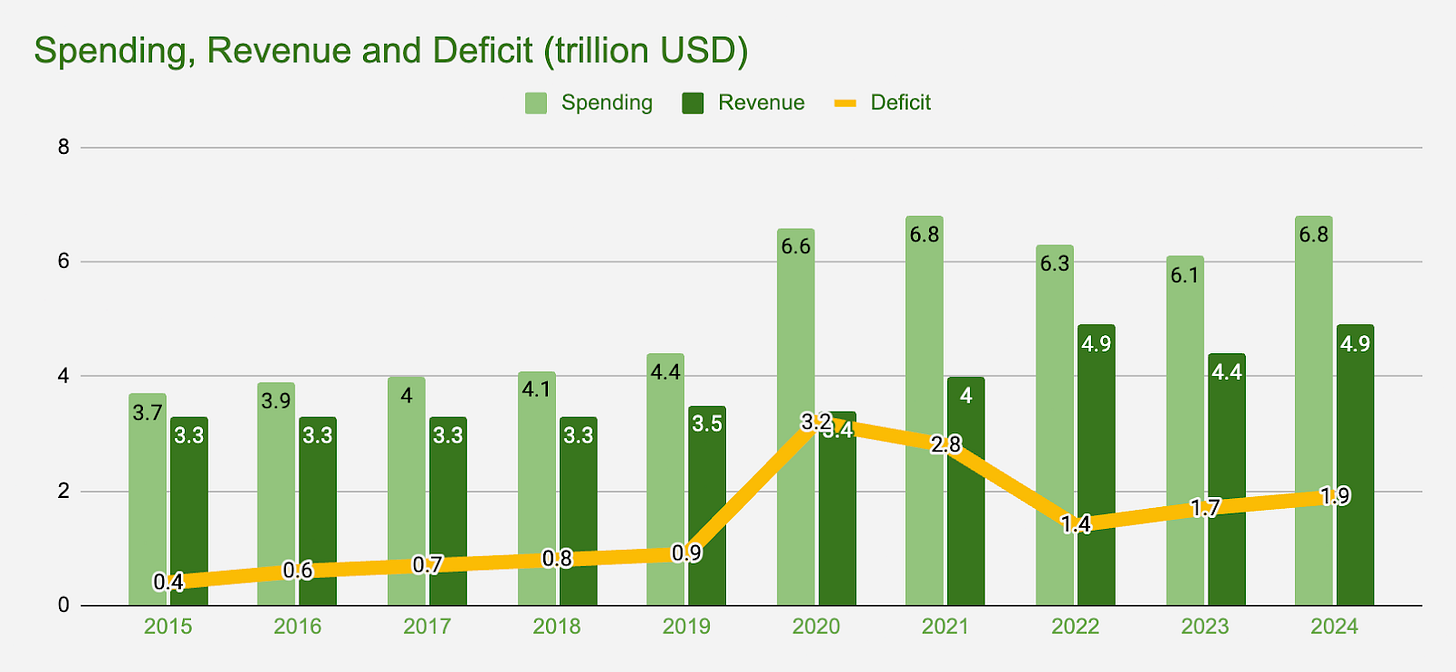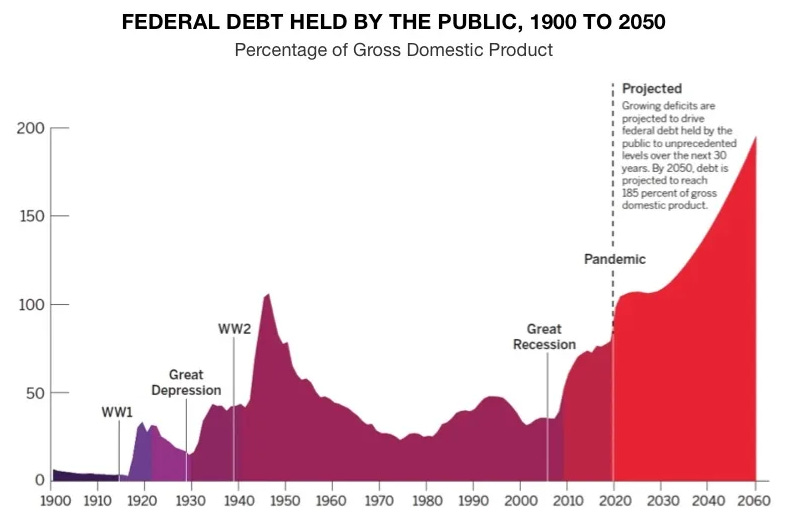Investing in the Trump Era: Navigating the Economic Shifts
A Look at the Short- and Long-Term Market Impacts of Trump's Policies
The Trump administration’s policies have sparked significant changes in the U.S. economy, with a focus on deregulation, tax reform, trade, and immigration. These policies aim to tackle some of the country’s biggest economic challenges, like the growing federal deficit, trade imbalances, inflation, housing affordability, and slowing productivity. But the big question is: will these policies deliver the economic transformation they promise? And what will their short- and long-term effects be on the economy and stock market?
The Trump Administration’s Economic Goals
The Trump administration, now in its second term, is pursuing a bold agenda aimed at reshaping U.S. politics and the economy. The focus is on deregulation, tax reform, trade policy, and immigration. Much of this agenda aligns with the playbook outlined in Project 2025 — a comprehensive manifesto created by The Heritage Foundation. This document outlines a four-pillar strategy that defines a conservative vision for governing and directly informs the administration’s economic priorities:
Deregulation and Economic Growth: Rolling back environmental, labor, and trade-related policies from previous administrations to reduce costs for businesses and consumers.
Tax Policy Overhaul: Proposals include reducing the corporate tax rate from 21% to 15% and extending individual tax cuts.
Trade and Tariff Policies: Protecting domestic industries and reducing trade deficits through tariffs and other measures.
Immigration and Labor Market Dynamics: Stricter immigration policies, including deportations and reduced visa programs, to address labor market challenges.
Why Economic Transformation Is Needed - challenges of the US economy
The U.S. economy faces several structural challenges that the administration’s policies aim to address:
Federal Budget Deficit
Government spending has skyrocketed, reaching $6.8 trillion in 2024. To put that into perspective, spending $1,000 a day would take 18.6 million years to hit $6.8 trillion. The deficit in 2024 was $1.9 trillion.
Source: Budget of the US Government
The national debt is now at an all-time high, exceeding $35 trillion, or 123% of GDP, making it the fifth highest in the world. If this trend continues, the debt could reach 200% of GDP by 2060.
Source: americanhartfordgold
Trade Deficit and Global Trade Risks
The U.S. goods trade gap is widening, with significant deficits in trade with China, the EU, and other major partners.
source: Bureau of Economic Analysis (BEA)
Below are the changes from 2024 December to 2025 January:
China ($-29.7 billion vs $-25.3 billion)
the EU ($-25.5 billion vs $-20.4 billion)
Switzerland ($-22.8 billion vs $-13 billion)
Mexico ($-15.5 billion vs $-15.3 billion)
Vietnam ($-11.9 billion vs $-11.4 billion)
Canada ($-11.3 billion vs $-7.9 billion)
These imbalances highlight the need for policies that protect domestic industries and reduce reliance on imports.
Inflation
Although inflation has come down from its peak of 9.1% in June 2022 to 2.8% in February 2025, it remains above the Federal Reserve’s target of 2%. Persistent inflation erodes purchasing power and creates uncertainty for businesses and consumers.
Health Care Affordability
The U.S. spends more on health care per capita than any other country, reaching $15,000 per person in 2025. Medical debt affects 41% of U.S. adults, and health care costs are projected to grow by 5.4% annually.
Housing Affordability
The U.S. faces a shortage of 3.8 million homes, driving up home prices and rents. Between 2020 and 2024, median wages grew by only 15%, while rents increased by 23% and home prices by 26%. Mortgage rates have risen to 7.2% in 2025, significantly increasing monthly payments for homebuyers. Nearly 30% of households are "cost-burdened," spending more than 30% of their income on housing.
Productivity Slowdown
Labor productivity growth has slowed significantly, from an average of 3.5% annually during the "Golden Age" (1948–1973) to just 0.8% in 2024. This slowdown limits economic growth and competitiveness.
How Trump’s Policies Could Impact the Economy and Markets
The administration’s policies aim to address these challenges, but their success depends on execution and long-term sustainability. Here’s a breakdown of the potential short- (during transition period) and long-term (after transition is completed) impacts:
Deregulation and Economic Growth
Short-Term Impacts:
Reduced regulatory costs could result in increase disposable income for families and boost consumer spending, but this could also drive inflation
Businesses, particularly in energy, automotive, and manufacturing, may see increased profitability and investment, driving stock prices higher.
Deregulation of domestic energy production could lead to lower energy prices and job creation in traditional energy sectors. Lower energy prices can also contribute to alleviating inflationary pressures.
Long-Term Impacts:
Deregulation may spur sustained economic growth by reducing barriers to business expansion and innovation.
Potential environmental and public health costs could offset some economic gains.
Traditional industries may thrive, but clean energy and environmental compliance sectors could face challenges.
Energy Sector Deregulation
Short-Term Impacts:
Increased investment in oil, natural gas, coal, and nuclear energy sectors could boost stock prices in these industries.
Mining and processing industries, especially those dealing with rare earth minerals, may see a surge in activity.
Appliance and vehicle manufacturers could benefit from reduced regulatory costs and increased consumer choice.
Long-Term Impacts:
Energy independence could strengthen national security and trade balance.
Traditional energy companies may maintain strong performance, while renewable energy companies could face reduced growth prospects.
Streamlined permitting processes may encourage long-term investment in infrastructure and energy projects.
Tax Policy Overhaul
Short-Term Impacts:
Lower corporate taxes and incentives for domestic manufacturing could boost business investment and job creation.
Extended individual tax cuts could increase consumer spending, benefiting retail and service sectors - this could also contribute to inflationary pressures
Long-Term Impacts:
Lower corporate tax rates could enhance U.S. competitiveness globally, but the federal deficit may increase without offsetting revenue or spending cuts.
Wealth inequality could worsen, potentially impacting consumer spending patterns over time.
Trade and Tariff Policies
With the new tariff system the global trading system how we knew it after WWII is now ceased to exist.
Short-Term Impacts:
Tariffs may protect domestic industries, boosting production in sectors like steel, aluminium, and agriculture.
Higher costs for non-replacable imported goods could reduce consumer spending and business investment - creating stagflation effects with price levels increasing up to 2.5-3.0%
The potential for significant job creation from reshoring production to the U.S. remains uncertain. Relocating manufacturing operations is likely to be economically viable primarily for roles requiring advanced skills or high levels of automation, given the substantial costs associated with such moves. Additionally, the higher wage levels in the U.S. present a competitive disadvantage compared to other countries, where labor costs are significantly lower—for example, wages in China are approximately 75% lower, in South Korea 60% lower, and in Germany 25% lower.
Long-Term Impacts:
Prolonged trade tensions have the potential to strain relationships with key trading partners, leading to a reduction in export opportunities for U.S. businesses. Additionally, such tensions may encourage other countries to establish alternative trade partnerships, diminishing the U.S.'s role in global markets.
Persistent higher prices for goods and inputs could slow innovation and investment in key industries - causing downward pressure on GDP growth.
Immigration and Labor Market Dynamics
Short-Term Impacts:
Labor shortages in agriculture, construction, and hospitality could lead to higher wages and production costs - which could cause inflationary effects
Reduced availability of high-skilled workers may slow innovation and growth in technology sectors.
Long-Term Impacts:
Couple of percent GDP losses from reduced labor force participation and productivity may happen.
Immigration restrictions may harm U.S. leadership in innovation and technology, reducing global competitiveness.
A shrinking tax base could increase fiscal deficits, slowing economic growth.
Key Takeaways
The Trump administration’s policies are ambitious and aim to tackle key economic challenges, but their success depends on execution and long-term sustainability.
Short-Term Impacts:
Deregulation and tax cuts could boost business investment, consumer spending causing inflationary effects
Tariffs can cause inflationary effects of up to 2.5-3.0%
Stock prices in traditional industries like energy, manufacturing, and automotive could boost
Uncertainty during the transition period, trade tensions, and labor shortages could create market volatility and inflationary pressures.
Long-Term Impacts:
If executed effectively, these policies could enhance U.S. competitiveness, energy independence, and economic growth.
On the flip side, risks include environmental degradation, fiscal deficits, reduced innovation, and strained global trade relations.
Immigration restrictions could harm productivity and innovation, while trade policies may disrupt global supply chains and reduce export opportunities.
Investment Outlook:
Traditional industries like energy and manufacturing may see sustained growth, while clean energy and tech sectors could face challenges.
Tech and clean energy sector could face challenges.
The ultimate success of these policies will depend on the duration and management of the transitional period, the effectiveness of their implementation, and their ability to address the structural challenges of the U.S. economy without introducing new risks.








